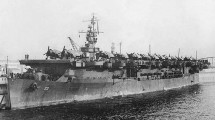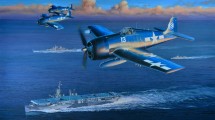Abstract
In August 2017, a multidisciplinary team conducted the first archaeological survey of the deep water (242 m) wreck of the ex-USS Bugara (SS/AGSS331) using the remotely operated vehicles Argus and Hercules. The survey provided 8 h of direct observation with video and still camera documentation of the wreck, which previously had been identified by sonar and a brief ROV survey of portions of the hull in 2001. The 2017 assessment added considerably to an understanding of changes to Bugara after it sank while under tow in 1971. Bugara, a World War II-era submarine, served at the end of that conflict and through the Cold War. The submarine reflects a series of modifications to “modernize” it within the context of the Cold War. The examination of the wreck, along with additional archival research, offers more details not only on the probable cause of the sinking but also on subsequent site formation processes. The characterization of the wreck resulted in a reassessment of the site as more than an obsolete vessel accidentally lost when relegated to target practice. The archival record, now declassified, shows that Bugara’s loss also reflects its ultimate use, within the context of the Cold War, as a target for the Mark 48 torpedo, a newly developed “sub and ship killing” weapon designed in the late 1960s and tested through 1971 to take out Soviet deep-diving nuclear submarines and high-performance surface ships.










Image courtesy of Ocean Exploration Trust

Image courtesy of Ocean Exploration Trust

Image courtesy of Ocean Exploration Trust

Image courtesy of Ocean Exploration Trust

Image courtesy of Ocean Exploration Trust

Image courtesy of Ocean Exploration Trust

Image courtesy of Ocean Exploration Trust

Image courtesy of Ocean Exploration Trust
Similar content being viewed by others
References
Alden JD (1979) The fleet submarine in the U.S. Navy: a design and construction history. Naval Institute Press, Annapolis
Brennan ML et al (2018) Telepresence-enabled maritime archaeological exploration in the deep. J Marit Archaeol. https://doi.org/10.1007/s11457-018-9197-z
Commander U.S. Pacific Fleet (2008) Northwest training range complex environmental impact statement/overseas environmental impact statement. http://www.nmfs.noaa.gov/pr/pdfs/permits/nwtrc_deis_vol1.pdf. Accessed Jan 2018
Delgado JP et al (2016) Initial archaeological survey of the ex-USS Independence (CVL-22). J Marit Archaeol 11:9–24
Department of the Navy (2007) Northwest training range complex management plan, volume II, final draft. Prepared for Commander, U.S. Fleet Forces and Commander, U.S. Pacific Fleet Pearl Harbor, HI and Commanding Officer Engineering Field Activity, Northwest Naval Facilities Engineering Command Contract # N68711-02-D-8043
Friedman N (1994) U.S. submarines since 1945: an illustrated design history. Naval Institute Press, Annapolis
Hanrahan JC (2017) Feasible explanation for the sinking of the USS Bugara SS-331, report included in a personal communication to George Galasso, Olympic Coast National Marine Sanctuary, August 30
Hanson TA (2016a) The archaeology of the Cold War. University Press of Florida, Gainesville
Hanson TA (2016b) Being sine qua non: maritime archaeology and the archaeology of the Cold War. J Marit Archaeol 11:5–8
Neyland RS (2016) USS Independence as a relic of both World War II and the Cold War. J Marit Archaeol 11:1–3
Polmar N, Moore KJ (2004) Cold War submarines: the design and construction of U.S. and Soviet submarines. Potomac Books, Washington, DC
Thompson F (2017) Curator Branch, Naval History and Heritage Command, personal communication, September 14
Author information
Authors and Affiliations
Corresponding author
Rights and permissions
About this article
Cite this article
Delgado, J.P., Cantelas, F., Schwemmer, R.V. et al. Archaeological Survey of the Ex-USS Bugara (SS/AGSS331). J Mari Arch 13, 191–206 (2018). https://doi.org/10.1007/s11457-018-9198-y
Published:
Issue Date:
DOI: https://doi.org/10.1007/s11457-018-9198-y




